Gender effects in advertising
add+impact group
Introduction: the (not so) blank slate Since Aristotle, people have believed that at birth our minds are empty, a virtual blank slate, which will develop through reason and experience. It followed that any so-called gender differences emerged after birth and derived from social and psychological conditioning (Aristotle 350bc; Pinker 2002).However, the accumulating evidence strongly indicates the contrary. Wechsler had some difficulty finding gender-neutral measures, and regarded the differences in scores between males and females as a ‘nuisance’ (Moir & Jessel 1991). In-utero hormonal flows result in brains that already have gender-related predispositions at birth (Baron-Cohen 2003a; Brizendine 2007). For such intrinsic differences to exist, adaptive selection of physiological differences must have been taking place in humans long before our species became big-brained, conscious and forward thinking. Such hard-wired differences result in intrinsically different male and female personalities, and ways of dealing with issues, general approach and reactions in life (Baron-Cohen 2003a).
Advertising effects models have typically employed a similar paradigm, treating target audiences as effectively having no mental brand history and hence no predispositions based on their existing feelings about, and experience of, the advertised brand. This meant that all responses to advertising were measured from a notional zero base (Ambler 1998). A brief personal reflection will demonstrate that this perception is inconsistent with one’s own reality and hence cannot be valid in general. Rather, the way we respond to ads is a function of what we know and how we feel at the time about ourselves, about the brand, its competitors and our perceived needs.
Another long-held marketing belief has been that if the audience simply becomes aware of the advertising, then it has done its primary job, even if the brand is unregistered. However, simply getting audience attention is insufficient. It is the capacity of the ad to engender enhancement of generally pre-existing brand feelings that predicts the level of increased purchase intent after advertising exposure (Cramphorn & Meyer 2009).
Brand feelings are outcomes of an aggregated synthesis of brand emotions and experience over time. Advertising seeks to change these feelings. Advertising is most effective when the target is engaged with the advertising and with the advertised brand. Emotional changes in brand feelings are the best predictor of increased purchase intent after advertising exposure. Ability to gain advertising attention and reinforce brand feeling leads to strengthened purchase intent.
The generalised advertising response (Gear) model process (Figure 1) demonstrates that, after initial exposure to the ad (Watchability), the next phase is an enhancement of existing Brand–Person Relationships (formed from prior brand experience), resulting in changed Purchase Intent as the outcome of the ad (Cramphorn & Meyer 2009). Based upon this conclusion, this paper looks at the gender differences in advertising response that correspond to Watchability (Attention) and Brand–Person Relationship (Brand Impact).
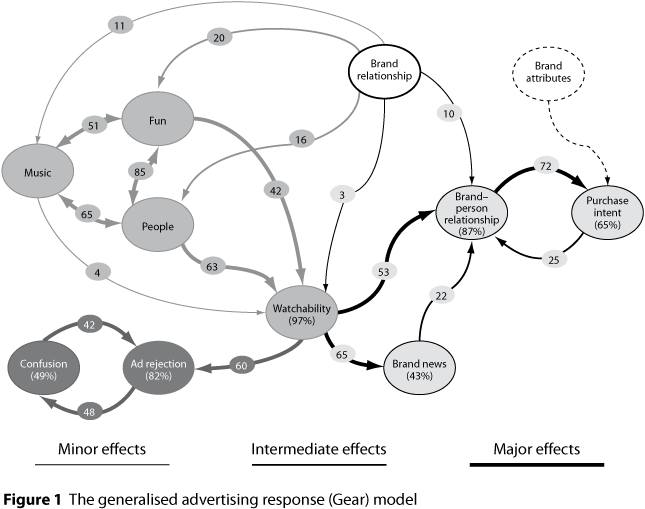
Females and males
At conception, two XX chromosomes lead to a female, while XY chromosomes result in a male (Moir & Jessel 1991). Gender effects commence shortly after conception and extend throughout pregnancy. However, the XY will develop, and eventually be born looking and behaving like a male, only if the foetus, around the eighth week after conception, generates sufficient male hormones (Moir & Jessel 1991; Brizendine 2007). Subsequent flows later in pregnancy further affect physiological differences including brain structure. At the same time that the body is changing, so is the brain. Gender-related testeronic hormonal flows in-utero result in brains that, at birth, are already physiologically and psychologically either female or male, with distinct predispositions specific to one or the other gender.
The hypothalamus controls sexual behaviour, and, depending on strength of hormone flow (primarily testosterone), the foetus will generally develop along a typical male or a female pattern. These hormonal flows also affect many other parts of the brain that collectively determine each person’s priorities, attitudes and feelings, and their responses (Rhoads 2004; Brizendine 2007). ‘The female brain is predominantly hard-wired for empathy. The male brain is predominantly hard-wired for understanding and building systems’ (Baron-Cohen 2003a).
For males, the rather small bridge linking the two lobes in the male brain makes cross-communication between the left and right hand lobes relatively difficult. This resulted, aeons ago, in male left and right lobes becoming specialised. If damage occurs to one side of the brain, males are likely to lose particular skills dominated by the damaged side. However, such differences are much smaller in females. The female corpus callosum is far broader than in males, with the two sides in communication. Therefore, if one lobe is damaged, there is less apparent subsequent mental or other impact (Moir & Jessel 1991). These predispositions have implications for everyday thinking and behaviour.
From the very first days after birth, boys look at faces but are equally fascinated by inanimate ‘things’; baby girls fix on faces (Moir & Jessel 1991; Baron-Cohen 2003b; Rhoads 2004; Brizendine 2007). Girls talk earlier, read earlier, and handle grammar better and earlier than do boys. Remedial reading and stuttering is far more common in boys. Girls learn other languages more easily and are more proficient in their own (Moir & Jessel 1991).
A well-known behavioural difference between men and women is the natural, innate aggression of men. Even as small boys, their rough-and-tumble is preparation for violent conflict; they use their bodies physically for dominance. Males are more likely to be derogatory or verbally aggressive as a way of achieving dominance, for status or, more subtly, occupational achievement. Boys are also more socially independent, while little girls socialise, and use social skills and diplomacy to get their way.
Females use words and are more subtle (Brizendine 2007). From early on, girls ‘play’ at parenting and ‘try on’ social roles. Females are far more socially orientated and skilled than males. They have intimate social arrangements, are concerned to maintain them, and have more empathy towards their friends. They maintain more eye contact, and smile and laugh more often. They can more readily read faces and feelings; they tune in to body language and they manage situations through diplomacy instead of showdowns. They are cohesive and mutually supporting (Moir & Jessel 1991; Brizendine 2007). Women ruminate about things that depress them, while men engage in distracting activities to take their focus elsewhere. Women share their problems and anxieties with other women, while men tend to internalise them.
There are gender-based differences relating to hearing, vision, pain, tactile sensation, taste and smell, in most of which women have greater sensitivity than do men (Moir & Jessel 1991). For example, girls’ noses, as well as their palates, are more sensitive, they are more attuned to sound – they hear better, they can sing in tune more easily, discern variations in sounds more readily, and women can hear baby sounds that are inaudible to men (Moir & Jessel 1991; Brizendine 2007).
Women see differently: they have more rods and cones in the back of the retina and are more sensitive to the infrared end of the spectrum. They see better in the dark and have better lateral vision, better depth perception and greater ability to match shapes. Women have better visual memory, remembering landmarks and positions of objects. However, men cope better with bright light and, because they see more narrowly, are better able to focus in on an object.
Women are better able to develop memory for names and faces, and have greater sensitivity to others’ preferences. Women also have better memory for verbal material (Croft et al. 2007; York n.d.). They spell better, and are better at mathematical calculation. They are more dexterous.
Where males succeed, it is partly due to their greater ability to focus and systematise. This means that they are more adept at analysing patterns and systems. They know where they are and can predict where others will be. They have a better-developed ‘intuitional’ sense of direction. They are better at reading maps, while women are better at reading character.
Males can more easily manipulate three-dimensional objects, both physically and conceptually (Moir & Jessel 1991). Men are better at solving mathematical problems requiring abstract reasoning. They have a better sense of perspective and have better spatial skills.
In general, males are poor at things that females do well – they are poor at empathising and may have no such capacity. For example, autism is rare in females (Baron-Cohen 2003a, 2003b). Suffice to conclude that very early pre-natal gender development determines our interests, abilities and the sorts of people we are.
Engaging with advertising
Probably not all of the differences between males and females listed above will prove to be relevant to communication but, knowing them, we can start to hypothesise about how differently men and women might respond to advertising.
Males respond better to ads about self, while females are more externally focused (Brunel & Nelson 2003). This is in accord with the male self-reliance and female sociability noted earlier. An exhaustive review of the research findings published on gender concluded that females process advertising elaborately over multiple exposures, while males see it once and have ‘got it’ (and are unlikely to reprocess it, even if they are wrong) (Wolin 2003). However, Wolin also describes the difficulty of drawing substantive conclusions when the literature is full of inconclusive and often contradictory findings based on small or convenience samples. Croft et al. (2007) identify differences in how men and women communicate, noting its potential usefulness for marketing. Evans, Nairn et al. (2000) summarise and confirm the impact of brain–gender differences. In their review, they confirm that there is evidence that men short-cut to conclusions while women first attempt to assimilate all the information. In reporting a study of gender effects in direct mail they found that women respond well when they can empathise, that photographs are more effective with women, while men respond to bold messages.
Cunningham and Roberts (2007) found that advertisers do not address women, and list areas of opportunity. The advent of social networking systems such as Facebook may lead to more gender-tailored ads based on user profiles (Hoy & Milne 2010). However, a recent finding that men and women are similar in their online cognitive needs should give pause to any temptation to generalise too readily. Still, it is noteworthy that the authors mention a greater emotional involvement by women in online shopping (McMahon et al. 2009).
Data
The add+impact® archive is a large and detailed worldwide record of consumers’ responses to advertising over two decades. As a resource, it overcomes the problem of small samples, and its diversity enables study of systematic responses to different styles of advertising, different product categories and international differences. Hundreds of thousands of individual results from thousands of advertising pre-tests enable comparison of the relative levels of engagement of males and females.
In the research process, the ad is exposed individually to the respondent without any clutter. Thus, people respond to the ad itself, and are not distracted or sidetracked by other advertising material or other people’s presence or comments. This is of particular benefit for this study as results are ad-specific, which eliminates any possible contamination of results. Following exposure, each respondent completes a questionnaire relating specifically to the test ad. These measures are very extensive, and thoroughly explore how people feel about the ad and its execution, and about the brand.
At the time of the analysis, a subset of the archive was selected. This contained the detailed responses for 3,045 ads. These represent all those ads where there is a specific record of whether the individual respondents are male or female. The results obtained from these ads form the basis for this study. Information was gathered for over 50 statements; however, for this paper, only two factors, each relying on six statements, were included. For the reasons noted earlier in discussing the Gear model, the two factors chosen are response to the ad creative (Attention) and emotive feeling towards the brand (Brand Impact).
Results
Targeting by gender
Ads were post-classified into three classes: ads that were tested with either just males, just females, or those tested with both men and women (broad-brush). It seems reasonable to surmise that advertisers know the brands’ target markets, and that this latter class – ads tested with both males and females – had the intent to appeal to both genders (since increasing sample size to include both genders would have the undesirable effect of increasing study costs).
Some items are intended primarily for use by one or the other gender and, for such items, brand advertising was tested with just that gender (cleaners and baby food were historically of little interest to males). In fact, such single-minded targeting is rare. Table 1 shows that both males and females were tested for 83% of all ads tested. The sheer size of this proportion may either simply reflect a lack of consideration, insurance that neither gender is alienated, a desire to have a bit each way, or even reflect the ‘saving’ in making one ad, not two. However, Figure 2 suggests that advertisers do indeed advertise to their audiences so probably none of these alternatives applies.
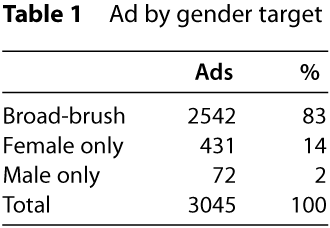
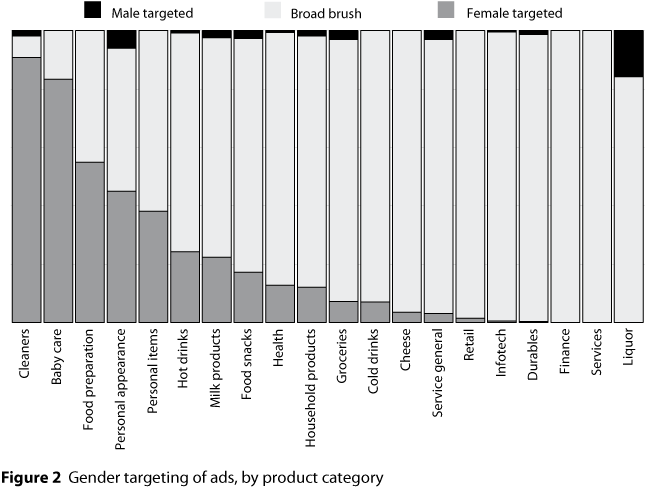
A breakdown of the figures in Table 1 by product category is summarised in Figure 2. This provides some insight into the extent to which what is being advertised determines the gender of those to whom it is being advertised.
From Table 1 and Figure 2, it emerges that, for most products and brands, advertisers rarely direct advertising to a particular gender and that most advertising is broad-brush. Thus, if the audience with whom each ad was tested is any guide, then most advertising for almost anything (except baby care, cleaners and food preparation) is directed to both genders.
Differences in response between males and females
If, as discussed, pre-natal effects do cause gender response differences, then we may logically expect to find that they are inherent in all societies and countries.
Figure 3 shows the difference in average response between males and females in their reaction to the creative ideas in all the 2,542 broad-brush ads. Both males and females were exposed to each of these ads, so the chart reflects real differences in response to the same stimuli. The base number of ads is contained in brackets for each country. Although the number of sample ads may seem comparatively small for some countries, it should be noted that this number refers to the number of different stimuli (ads) presented. Thus, the actual means are based on far larger numbers of individuals’ responses. In addition, it should be noted that the tendency for females to rate more highly is consistent, irrespective of country or sample size.
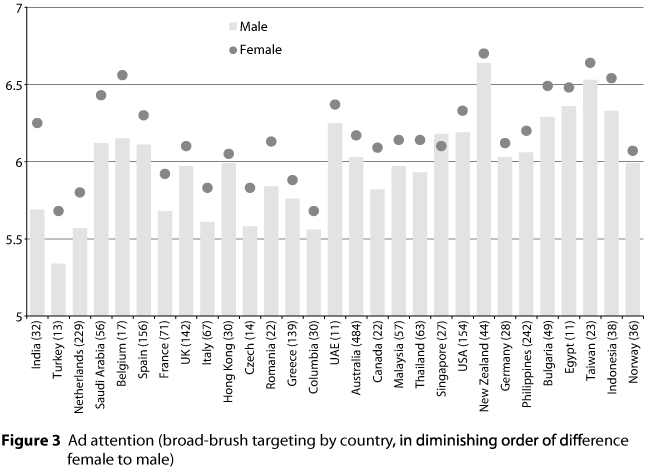
From Figure 3, it is quite apparent that females respond more positively to the creative in the same ads than men do. This consistency seems systemic and the relatively minor variations may be ascribable to subsequent social factors. This may account for the exception of Singapore, where men are more attentive to advertising than are women. However, even here, the advertising has more brand impact on females.
Geographically, the results are widely distributed without apparent regional or cultural clusters.
While Figure 3 demonstrates the difference in how men and women respond to the advertising creative executions, Figure 4 shows the difference in the viewers’ brand attachments after exposure to the advertising. (For ease of visual comparison, Figure 4 is shown in the same country order as Figure 3.)
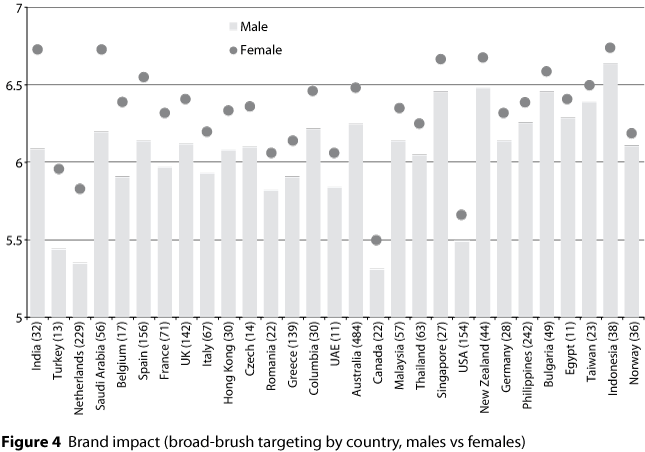
Figure 4 displays the consistent differences between how strongly women and men feel towards the advertised brands after exposure. These differences are generally more pronounced for brand impact than for advertising attention, reflecting a systemically greater emotive feeling towards brands by women. This accords with the overall patterns discussed earlier.
If the differences were gender intrinsic from birth, then any such differences should be consistent across all nations and cultures. As the chart shows, they are. Ockam argued for the simplest explanation. This is provided by accepting the pre-natal effects discussed earlier: that these results are further evidence of an intrinsic gender difference, and that women generally respond more positively to their environment. This is simply manifested in these results relating to advertising creativity and engagement with brands.
Advertising style
If men and women are intrinsically different, then we might expect them to respond differently to different styles of advertising. This can be tested: the overall style of each ad was classified at the time of testing (see Appendix 1). Figures 5 (Ad Attention) and 6 (Brand Impact) show the overall difference in response by Style where both males and females were exposed to the same ad. Males’ average ratings display as vertical light grey bars while a dark grey ball represents the generally more positive female rating. The styles in both charts are arranged in order of diminishing difference between the male and female Attention averages in order to highlight which styles are most effective in both relative and absolute terms.
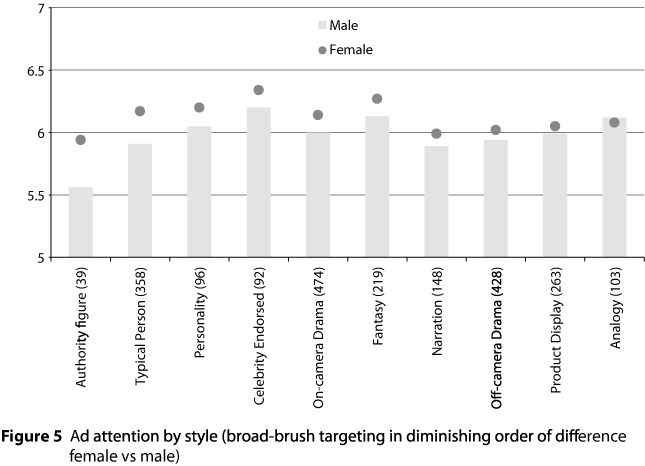
The scale of differences does vary in a predictable way in the light of the earlier discussion. The types of ad where females are much more positive than males are Authority Figure, Typical Person, Demonstration, Personality and Celebrity – that is, ads with people. Figure 5 reinforces the expectation of a more positive response to people by females.
Although still more positive than males, the styles with the fewest gender differences are Product Display, Off-camera Drama and Narration, where people have minimal presence. Analogy is slightly higher for males, suggesting that analogy is a style that men are more likely to accept (as found in other studies of male–female differences cited earlier).
Overall, the most effective attention-getters for females are ads that use Celebrities, Fantasy, Typical Person and Personalities (people). For males, the most effective styles are Analogy, Celebrities and Fantasy.
Figure 6 shows that, irrespective of advertising employed, females feel more positive to the brand after exposure to all styles of advertising, and that what is most effective in terms of getting Attention corresponds with Brand Impact.
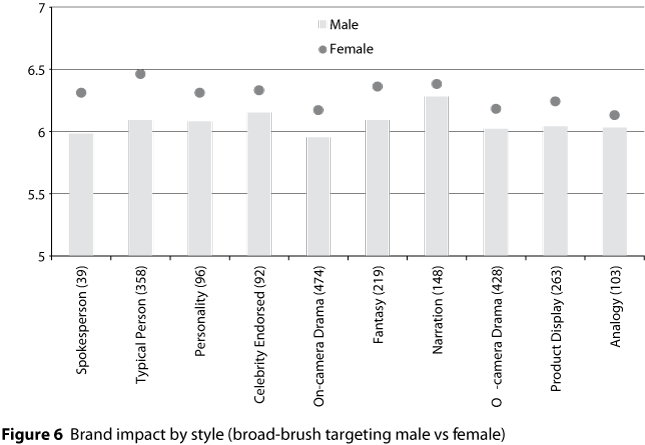
Ad content
In the same way as for Style, depending on the main content of the ad, gender differences might also be expected. This too can be considered: the primary content of each ad is also classified at the time of testing. How relatively effective are ads that employ comparisons, humour, music, etc. as the main theme?
Figures 7 and 8 show the results broken down by the overall content of the ad.
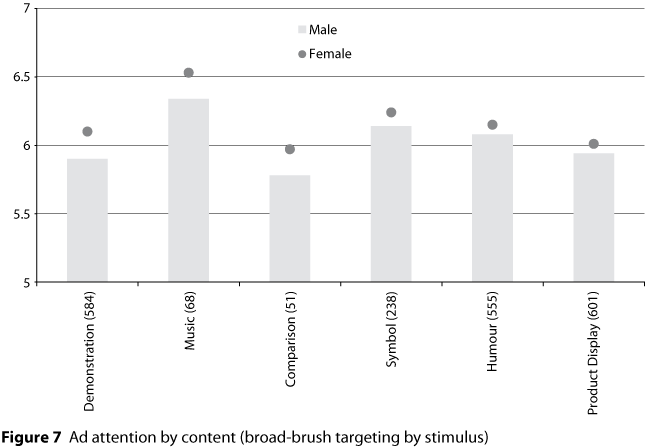
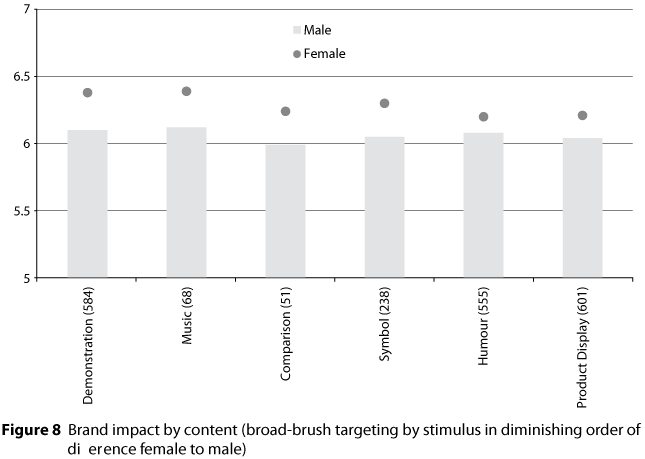
In what is becoming a familiar picture, females respond more positively in all situations (especially music), both to the creative and in terms of consequent brand feelings. Exemplifying the Gear model, the contribution of music is quite clear in terms of gaining ad attention for both genders.
Ads employing comparisons, while of relatively low interest, are very persuasive once viewed. Since such ads need to be viewed less frequently in order to get the message across, low interest may not be a problem.
Broad-brush vs gender targeting
If the objective is to maximise the advertising effect for a particular gender, then it ought to be the case that advertising tailored to a single gender will be more effective. This proves to be the case.
Females by category
Figures 9 and 10 for females compare the typical outcomes with gender-specific vs broad-brush targeting by product category. The categories have been limited to where there are sufficient cases to provide meaningful results. Respective ad numbers are shown in brackets.
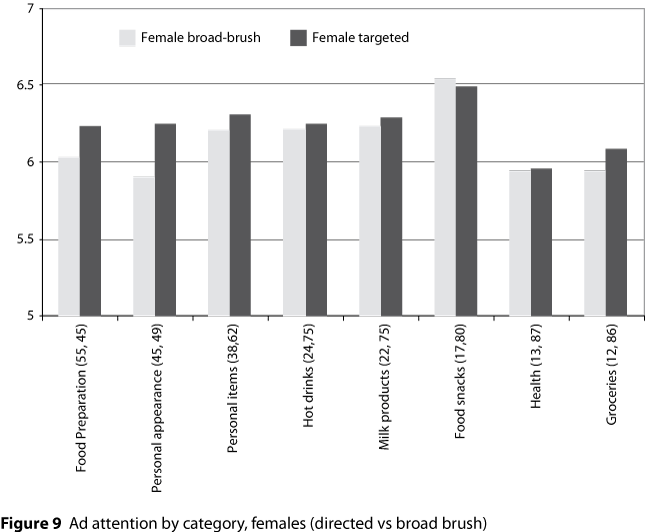
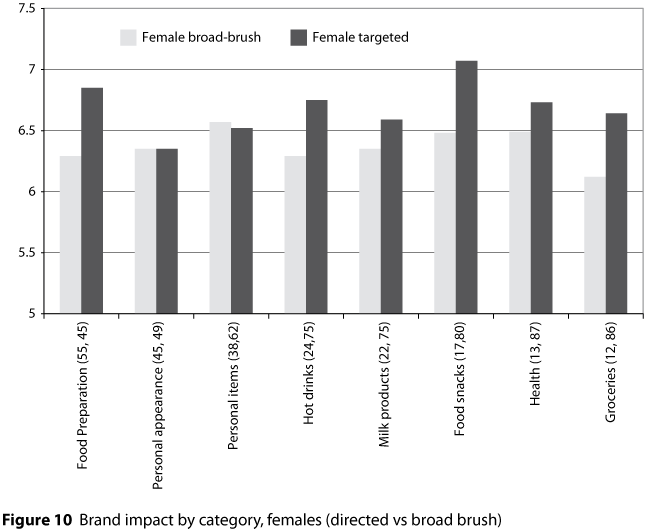
Figure 9 indicates that, with the exception of Food Snacks, women give more attention to ads directed to women. Figure 10 shows that, with the exception of personal appearance, women are more positive to the advertised brands that are targeted directly to them.
Females by style
As was the case when comparing female response by category, Figures 11 and 12 show that when the comparison is made between direct and broad-brush advertising, it does not matter which style is employed, the female-directed advertising is almost without exception more effective. The one exception was for advertising using a authority figure, which received low ratings whether gender-specific or broad-brush.
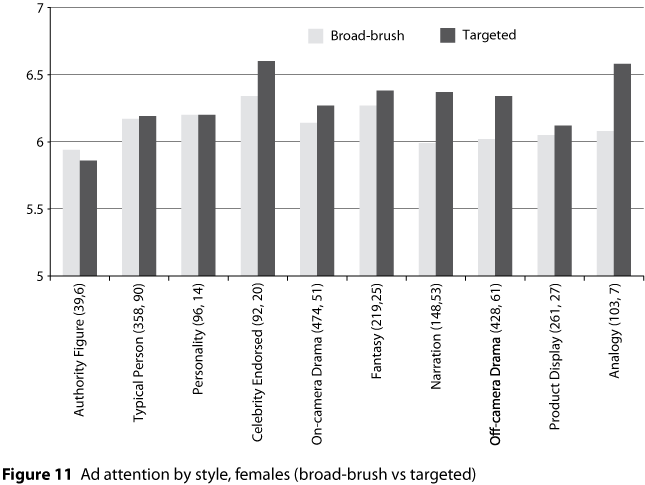
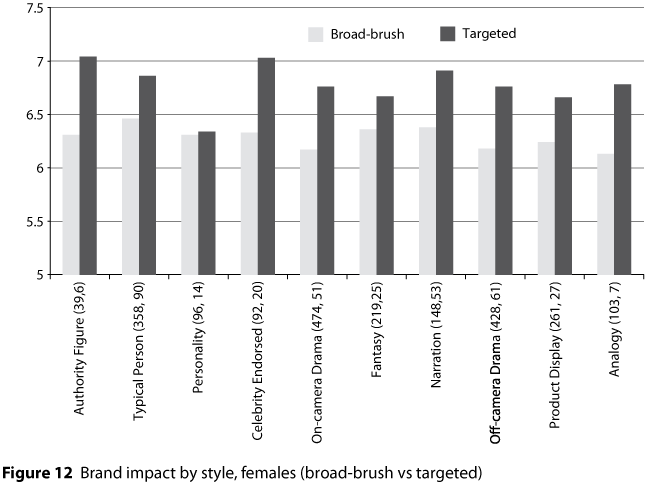
In terms of effective brand outcomes, female-directed advertising employing celebrities and authority figures leaves an exceptionally strong brand feeling. So, once more, ads that include people result in more positive responses from females.
This is even more likely to occur with ads that are specifically tailored to females.
Males by style
Although the pool of data for targeted male advertising is small and the number of ads in each style is relatively small, the corresponding analysis for males is shown in Figures 13 and 14 for completeness, and to show that the results are completely consistent. Males respond better when specifically targeted.
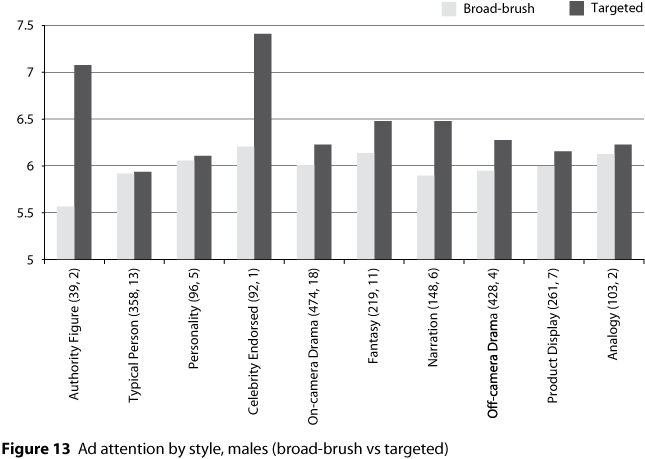
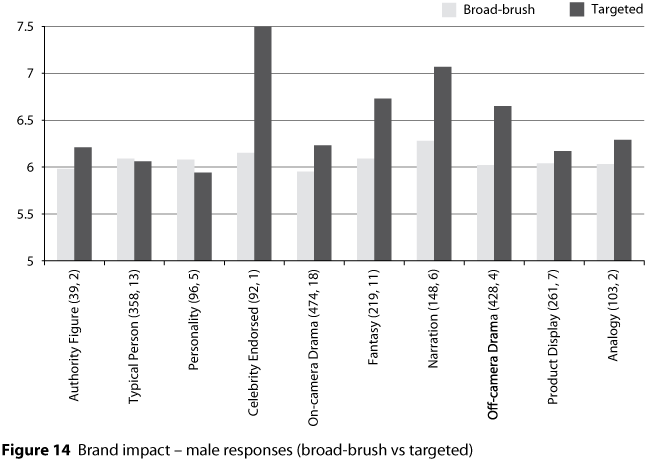
The charts consistently show that gender-directed advertising is more effective for advertising styles for males. If these outcomes were random (like tossing a coin), the probability of getting 10 out of 10 results where ‘targeted’ is better than ‘broad-brush’ is p = 0.001. This outcome is not a quirk of sampling!
In Figure 14, obtaining 8 out of 10 higher targeted outcomes for brand feelings is also significant (p = 0.043), and reinforces a conclusion that single-gender targeted advertising is more effective.
Selection of ad styles
The study has shown that some styles of advertising are more effective than others. Figure 15 shows the relative frequency of use of different ad styles for 2,220 broad-brush ads. Since they are the ads that clients selected for testing, they can be deemed a reasonable cross-section of advertising practice across the world.
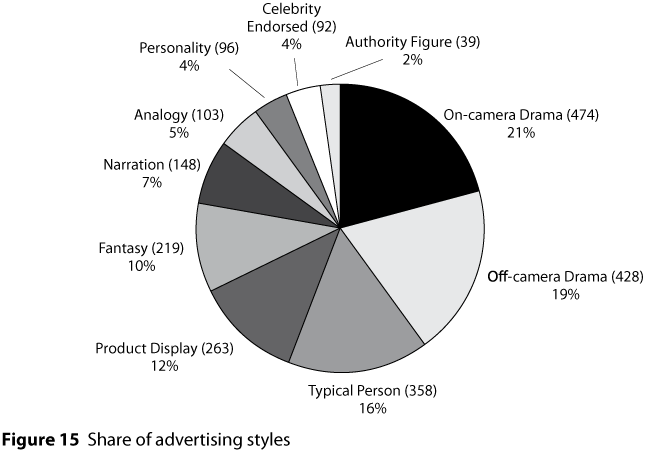
It is thus rather surprising to find that, of the 11 styles listed, just four (On- and Off-camera Drama, Typical Person and Product Display) account for over two-thirds of all advertising tested (and hence, presumably, of all ads).
Figures 16 and 17 reveal an interesting paradox. Frequency of use does not correlate with effectiveness of advertising style: advertisers under-utilise some of the most effective styles.
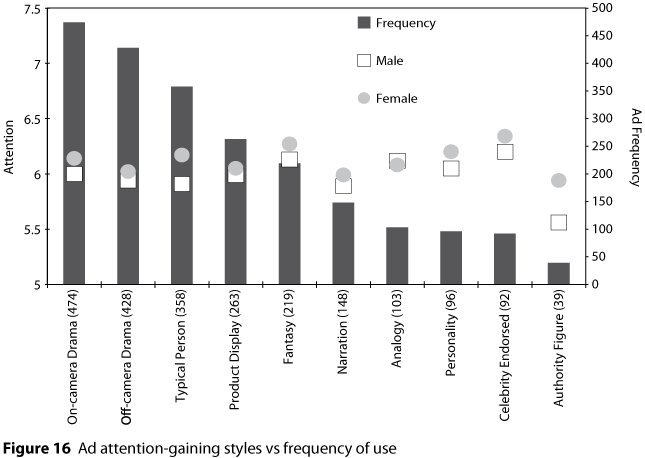
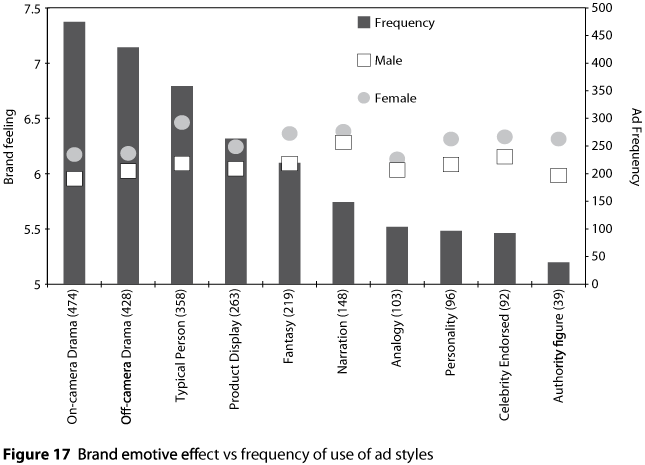
When the frequency of use of individual ad styles is contrasted with the actual effectiveness of the advertising in gaining audience attention, some styles dominate, while others that are at least as effective are seldom employed. For example, Celebrities, Personalities and Analogy are powerful as attention getters (Figures 5 and 6), yet are seldom employed.
Selection of ad main content
Another way to look at the results is to look at the frequency with which ads with a particular content emphasis are used, and compare that frequency with the relative efficiency of the advertising in terms of creative impact and eventual brand feeling.
Figures 18 and 19 show some interesting anomalies. In essence, they show that almost all advertising historically falls into just three styles: product display, demonstration and use of humour. As noted, humour is an efficient adjunct of effective advertising, but to a similar extent, so is music (see Figures 7 and 8). Curiously, as Figure 18 shows, advertisers seldom use either music or comparison-based ads.
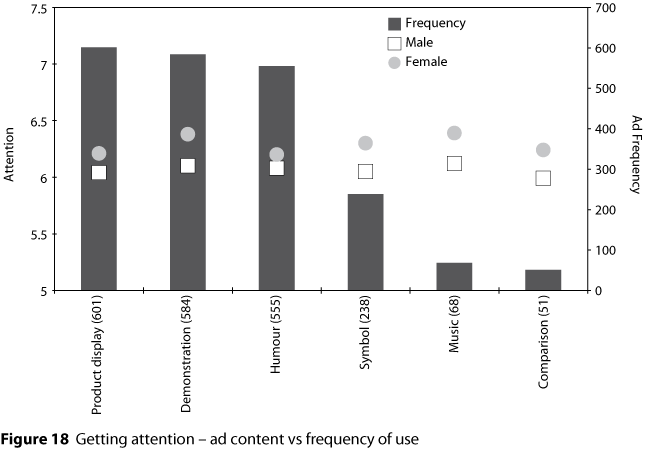
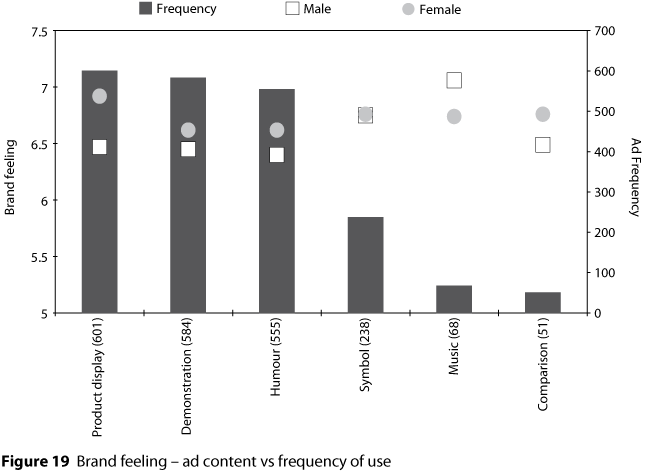
Key findings
General
- By far the majority of advertising tested is directed broad-brush to males and females. However, this is a questionable practice since ads targeted specifically either to males or females are likely to be more effective than those targeted to both.
- Whatever style of advertising is employed, females are likely to respond more positively to it. Confirming the hard-wired gender predisposition findings, gender differences are not due to cultural effects, and different countries experience broadly similar outcomes.
- Ads containing music are consistently effective, yet are seldom utilised.
- Advertisers employ a very limited range of advertising styles. In developing their advertising, they could employ a much wider range and introduce alternative content that would be at least as effective, and often more effective.
- Humour, which is widely used because of its ability to gain awareness, emerges as a double-edged sword. It does not necessarily enhance Brand Impact. Perhaps some humour may result in adverse rub-off on the brand.
- The most effective styles of advertising to females are ads employing Fantasy, a Typical Person and Personalities.
- The introductory discussion identified that females are more socially orientated. It is thus not surprising to find that females respond more positively than males to advertising with people in it (Personality, Celebrity, Typical Person). However, these formats are comparatively under-utilised.
- The most effective ad styles for males are Analogy (a sort of abstraction), Celebrity and Fantasy.
- The use of music leaves males very strongly branded to the advertised brand, but it is seldom employed.
Implications
A slightly higher benchmark may be appropriate for evaluating female responses to advertising, especially in countries where the disparity is large.
Unless advertising production costs are prohibitive, there is a strong case to be made that ads should specifically target females or males when they are the primary intended audience.
It is often asked whether the use of celebrities can be justified. These results support the use of celebrities for advertising, especially when directed to females, as it results in both high attention and high brand impact.
Different styles of advertising work best for women and men. Given the degree of overlap, one may conclude that men do not respond more negatively per se, but rather that men respond positively when the appropriate stimulus is presented. However, assuming what has been tested broadly represents the types and styles of advertising used, then these typical advertising approaches are less well suited to males in almost any category or style of advertising.
Application of these findings should lead to a fine-tuning of the advertising approach rather than a total revolution. The best approach to advertising any product can be determined by examining what works best on a category-by-category basis. Often, current practice is sub-optimal.
It is hard to avoid the conclusion that advertisers are missing some creative opportunities and are somewhat formulaic. As advertisers seek to preserve their traditional offline forms of communication, they will need to raise their game. These results show them a direction in which to go.
Clearly, these are preliminary conclusions and should act as a stimulus to further investigation. However, here are some things to think about …
Five golden rules
- Intrigue males with symbols and abstraction.
- Involve females with empathetic people-populated situations.
- Beware of making too light of what you are saying lest you belittle your subject matter.
- Relevant celebrities and personalities can pay dividends.
- Make music when you advertise!
Appendix 1: Definition of ad styles
Typical Person A non-celebrity delivers the product benefits by endorsing the brand
Celebrity Endorsed A famous celebrity delivers the product benefits by endorsing the brand
Authority Figure A celebrity presents the sales message in an announcement format, but no testimonial is provided
Personality An individual who is the focus of the ad is engaged in some activity but is not providing a testimonial or verbally endorsing the product
Off-camera Drama A drama portraying life or character by means of dialogue or action is performed in the commercial, but the sales message is delivered by an announcer not involved in the drama (usually unseen by the audience)
On-camera Drama Primary sales messages are delivered by the performers engaged in the drama
Narration The story is depicted in the video while an off-camera announcer discusses the advertised product and relates what is happening on-camera. The distinguishing feature between narration and drama is that a story is told, not dramatised
Demonstration The dominant aspect of the commercial is the demonstration of product features
Product Display Product is displayed or shown in use, but no specific product features are demonstrated
Fantasy Ads employing imaginative or unnatural plots and characterisations, e.g. talking animals or cartoon characters
Analogy The product is compared, by analogy, to an unrelated item (such as an animal or a jewel) and the analogy is the focus of the commercial
Mood/Collage The ad is made up of a collage of unrelated images and scenes. Voice-over is given by an off-camera announcer.
http://www.warc.com/Content/ContentViewer.aspx?ID=0e31ff17-9d87-4275-a8b3-fe067bc02180&ID=0e31ff17-9d87-4275-a8b3-fe067bc02180&MasterContentRef=0e31ff17-9d87-4275-a8b3-fe067bc02180

No comments:
Post a Comment